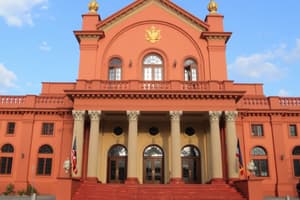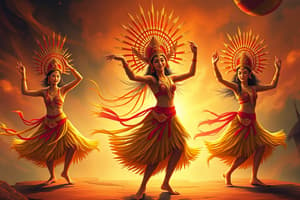Podcast
Questions and Answers
What term did these groups prefer to be called instead of national minorities during the time of PANAMIN?
What term did these groups prefer to be called instead of national minorities during the time of PANAMIN?
- Nationalist Tribes
- Ethnic Minorities
- Cultural Nationalities (correct)
- Tribal Filipinos
Which mountain range is mentioned as the location where the Igorots live?
Which mountain range is mentioned as the location where the Igorots live?
- Sierra Nevada
- Rocky Mountains
- Appalachian Mountains
- Sierra Madre (correct)
What is the meaning of the original name 'Ygorot' given to these people?
What is the meaning of the original name 'Ygorot' given to these people?
- People of the Mountain (correct)
- People of the River
- People of the Sea
- People of the Valley
Where did these groups settle after being forced to vacate the lowlands by the Spaniards?
Where did these groups settle after being forced to vacate the lowlands by the Spaniards?
What term is commonly attached to the cultural presentations of these groups?
What term is commonly attached to the cultural presentations of these groups?
What name do these groups prefer today over being called Igorots?
What name do these groups prefer today over being called Igorots?
Which of the following is NOT a factor contributing to the tribal dances of the Philippines?
Which of the following is NOT a factor contributing to the tribal dances of the Philippines?
How does the economy affect tribal dances?
How does the economy affect tribal dances?
Which of the following factors is NOT mentioned in the text as affecting tribal dances?
Which of the following factors is NOT mentioned in the text as affecting tribal dances?
How does the topography/environment affect tribal dances, according to the text?
How does the topography/environment affect tribal dances, according to the text?
What factor affects the type of clothing and textiles worn during tribal dances?
What factor affects the type of clothing and textiles worn during tribal dances?
Which of the following statements is TRUE according to the text?
Which of the following statements is TRUE according to the text?
What do the multi-racial roots of Filipinos form in the Philippines?
What do the multi-racial roots of Filipinos form in the Philippines?
How are ethic groupings identified in the Philippines?
How are ethic groupings identified in the Philippines?
What is the common goal or objective of an ethnic group?
What is the common goal or objective of an ethnic group?
Why do some groups resent being called ethnic nowadays?
Why do some groups resent being called ethnic nowadays?
What is another word used to describe groupings based on cultural characteristics?
What is another word used to describe groupings based on cultural characteristics?
Where are lesser-known groups often associated with in terms of location?
Where are lesser-known groups often associated with in terms of location?
Which tribe is believed to be the original settlers of Mindanao?
Which tribe is believed to be the original settlers of Mindanao?
Which tribe is prominently identified with their colorful attire and graceful dancing?
Which tribe is prominently identified with their colorful attire and graceful dancing?
Which tribe is closely related to Muslims in some beliefs and traditions, but considers themselves as non-Muslim?
Which tribe is closely related to Muslims in some beliefs and traditions, but considers themselves as non-Muslim?
What is the meaning of the name 'Subanon'?
What is the meaning of the name 'Subanon'?
Which of the following tribes is not mentioned in the text?
Which of the following tribes is not mentioned in the text?
What is the common acronym used to refer to the groups mentioned in the text?
What is the common acronym used to refer to the groups mentioned in the text?
What is the typical clothing worn by the men in these groups?
What is the typical clothing worn by the men in these groups?
Which of the following colors are not mentioned as being used by these groups?
Which of the following colors are not mentioned as being used by these groups?
Which term is used to refer to the Aetas, considered the first inhabitants of the Philippines?
Which term is used to refer to the Aetas, considered the first inhabitants of the Philippines?
What is the defining characteristic of the Aetas and other similar groups mentioned?
What is the defining characteristic of the Aetas and other similar groups mentioned?
Which group is mentioned as having a written language that pre-dates the Spanish colonial period?
Which group is mentioned as having a written language that pre-dates the Spanish colonial period?
Flashcards are hidden until you start studying
Study Notes
Spanish Colonization and Resistance
- During the Spanish colonization, many ethnic groups in the Philippines exhibited strong resistance against the Spaniards, forcing them to vacate the lowlands and settle in the hinterlands of the Cordillera mountains, the forests of Mindoro and Palawan, and the thick woods of Mindanao.
PANAMIN and Ethnic Groups
- PANAMIN, an acronym for Presidential Assistance on National Minorities, identified 37 major ethnic groups in the country based on ethno-linguistic groupings and cultural activities.
- Many ethnic groups opposed being called "national minorities" and preferred to be referred to as "Cultural Nationalities" or "Tribal Filipinos".
Igorots and Cordillera Tribe
- The Igorots, originally known as Ygorot, meaning "people of the mountain", live in the jungles of Northern Luzon, specifically in the mountains of Sierra Madre and Cordillera.
- Today, they prefer to be called Cordillera tribe or people, as they have managed to live similarly to the lowlands, including their way of life.
Tribal Groups in the Cordillera Region
- The Kalingas, Tinggians or Itneg, and Apayaos live in the northernmost area of the Cordillera.
- The Ifugaos and Gaddangs live in the central area of the region.
- The Benguets, Kankanais, and Ibalois live in the southern part of the region.
Factors Affecting Tribal Dances
- Topography/Environment: the land area where they live and its surrounding environment affect their dancing.
- Climate/Weather: the kind of clothing and textile being worn greatly affect their dance.
- Religion: the governing rules of their beliefs affect their dancing.
- Economy: the means to survive and the way to compete in the demands of society where they live affect their dancing.
- Political Organization: although they have communal rules of their own, they belong to a bigger society within the country, which affects their dancing.
- Education: the kind of information and knowledge gained by them as they acquire and take the process of learning affect their dancing.
- Science and Technology: the inventions and wonders brought by science are big factors in affecting their dance and dancing.
Ethnic Groups in the Philippines
- The multi-racial roots of the Filipinos formed the various ethnic groups found in the entire archipelago of the Philippines.
- Ethnic groups are identified from their language or dialect spoken, religion, common art form such as dance, music, and many others.
Tribal Groups in Mindanao
- The northern part of Mindanao within its thick forest and high mountains dwells the many tribal groups, including the Manobos, Bukidnons, Talaandig, Umayamon, Higaunon, Matigsalug, Tagbanwa, Tasaday, and many other smaller communities.
- The Bagobos are prominently identified with their colorful attire and graceful dancing.
Other Tribal Groups
- The Subanon, who are settlers near the river, got their name from the word subs meaning river.
- The B'laans are dwellers in the Cotabato regions.
- The Tirurays are also dwellers in the Cotabato regions.
- The T'boli tribe are closely Muslims in some beliefs and traditions, but they consider themselves as non-Muslim.
- The Aetas, believed to be the first inhabitants of the archipelago, are scattered in the mountains of Mindoro, Zambales, Romblon, Palawan, and in some parts of Visayas island.
- The Mangyans, also known as Buhid, Buid or Hanungo, are remarkably identified in successfully preserving a written language of pre-hispanic origins.
- The people of Palawan are believed to be the remnants of migrant waves that have settled in the country.
Studying That Suits You
Use AI to generate personalized quizzes and flashcards to suit your learning preferences.




